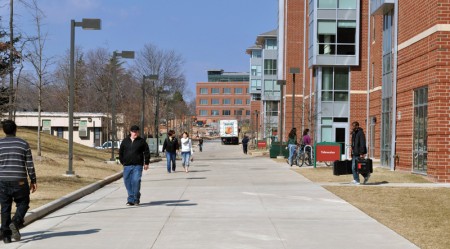
Photo By Gregory Connolly.
The Carnegie Foundation for the Advancement of Teaching has officially classified George Mason University as a “primarily residential” campus. Long considered a commuter school, Mason has increased its profile in recent years through growing academic reputation, student activities and new residential buildings.
Jana Hurley, executive director of Housing and Residence Life, said she believes “the driver for the demand in housing is mostly related to Mason’s increasingly recognized and effectively promoted excellence as an educational institution, its overall enrollment growth and the general commitment of the university to invest its resources in making all aspects of the university the best possible experience for our students.”
According to statistics from Mason’s website for the 2009-10 school year, there were 19,130 undergraduate students. Of that number, 1,857 were freshman and 4,996 lived on campus. For an institution to qualify as primarily residential, 25 to 49 percent of undergraduates must live in campus housing.
Hurley said there is currently space for approximately 5,400 students, but this number will increase to 6,000 in the fall. She also said there are an increasing number of graduate students living on campus.
“The demographics related to who is living on campus have really shifted as we have constructed a considerable amount of housing designed to meet the needs and expectations of upper class students,” Hurley said.
Crucial to Mason’s residential life is the development of student housing, including the recently completed Hampton Roads and Eastern Shore dorms, both completed in 2010. Space will increase with the addition of a 600-bed facility still under construction. Listed as Housing VIII by Facilities Management, this building is scheduled to open in August of 2012 on the northwest section of the Fairfax campus.
Not all students have noticed the change. Freshmen Afreen Habib, Zainab Ibrahim and Parul Mittal all said one of the reasons they chose Mason was for its proximity to home.
Though they said it still seems like a lot of students live at home, Mason is trying to create an environment that is friendly to students both on and off campus.
“It is important for students to know that they will have a place to live if they need one,” Hurley said.
Mason is trying to put the focus on students when it comes to future growth. Hurley said the administration is considering students’ wants and needs while they plan the allocation of university resources and additional housing. Especially in light of this new classification, major consideration will be given to how university resources will be affected and used by residential students.
Hurley is positive about this change and what it will do for Mason. She said benefits include increases in recruiting and retention efforts and in student services, as well as “the kind of student engagement opportunities and continuous 24-hours-a-day energy which is a hallmark of today’s residential campuses.”






Comments